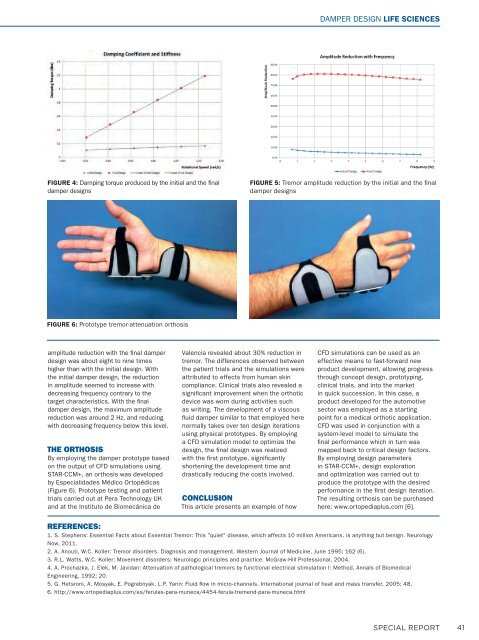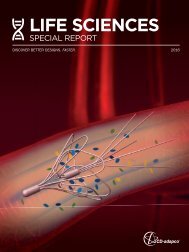Life science special report 161215 IY opt
You also want an ePaper? Increase the reach of your titles
YUMPU automatically turns print PDFs into web optimized ePapers that Google loves.
DAMPER DESIGN LIFE SCIENCES<br />
FIGURE 4: Damping torque produced by the initial and the final<br />
damper designs<br />
FIGURE 5: Tremor amplitude reduction by the initial and the final<br />
damper designs<br />
FIGURE 6: Prototype tremor-attenuation orthosis<br />
amplitude reduction with the final damper<br />
design was about eight to nine times<br />
higher than with the initial design. With<br />
the initial damper design, the reduction<br />
in amplitude seemed to increase with<br />
decreasing frequency contrary to the<br />
target characteristics. With the final<br />
damper design, the maximum amplitude<br />
reduction was around 2 Hz, and reducing<br />
with decreasing frequency below this level.<br />
THE ORTHOSIS<br />
By employing the damper prototype based<br />
on the output of CFD simulations using<br />
STAR-CCM+, an orthosis was developed<br />
by E<strong>special</strong>idades Médico Ortopédicas<br />
(Figure 6). Prototype testing and patient<br />
trials carried out at Pera Technology UK<br />
and at the Instituto de Biomecánica de<br />
Valencia revealed about 30% reduction in<br />
tremor. The differences observed between<br />
the patient trials and the simulations were<br />
attributed to effects from human skin<br />
compliance. Clinical trials also revealed a<br />
significant improvement when the orthotic<br />
device was worn during activities such<br />
as writing. The development of a viscous<br />
fluid damper similar to that employed here<br />
normally takes over ten design iterations<br />
using physical prototypes. By employing<br />
a CFD simulation model to <strong>opt</strong>imize the<br />
design, the final design was realized<br />
with the first prototype, significantly<br />
shortening the development time and<br />
drastically reducing the costs involved.<br />
CONCLUSION<br />
This article presents an example of how<br />
CFD simulations can be used as an<br />
effective means to fast-forward new<br />
product development, allowing progress<br />
through concept design, prototyping,<br />
clinical trials, and into the market<br />
in quick succession. In this case, a<br />
product developed for the automotive<br />
sector was employed as a starting<br />
point for a medical orthotic application.<br />
CFD was used in conjunction with a<br />
system-level model to simulate the<br />
final performance which in turn was<br />
mapped back to critical design factors.<br />
By employing design parameters<br />
in STAR-CCM+, design exploration<br />
and <strong>opt</strong>imization was carried out to<br />
produce the prototype with the desired<br />
performance in the first design iteration.<br />
The resulting orthosis can be purchased<br />
here: www.ortopediaplus.com [6].<br />
REFERENCES:<br />
1. S. Stephens: Essential Facts about Essential Tremor: This "quiet" disease, which affects 10 million Americans, is anything but benign. Neurology<br />
Now, 2011.<br />
2. A. Anouti, W.C. Koller: Tremor disorders. Diagnosis and management. Western Journal of Medicine, June 1995; 162 (6).<br />
3. R.L. Watts, W.C. Koller: Movement disorders: Neurologic principles and practice. McGraw-Hill Professional, 2004.<br />
4. A. Prochazka, J. Elek, M. Javidan: Attenuation of pathological tremors by functional electrical stimulation I: Method. Annals of Biomedical<br />
Engineering, 1992; 20.<br />
5. G. Hetsroni, A. Mosyak, E. Pogrebnyak, L.P. Yarin: Fluid flow in micro-channels. International journal of heat and mass transfer, 2005; 48.<br />
6. http://www.ortopediaplus.com/es/ferulas-para-muneca/4454-ferula-tremend-para-muneca.html<br />
SPECIAL REPORT<br />
41



